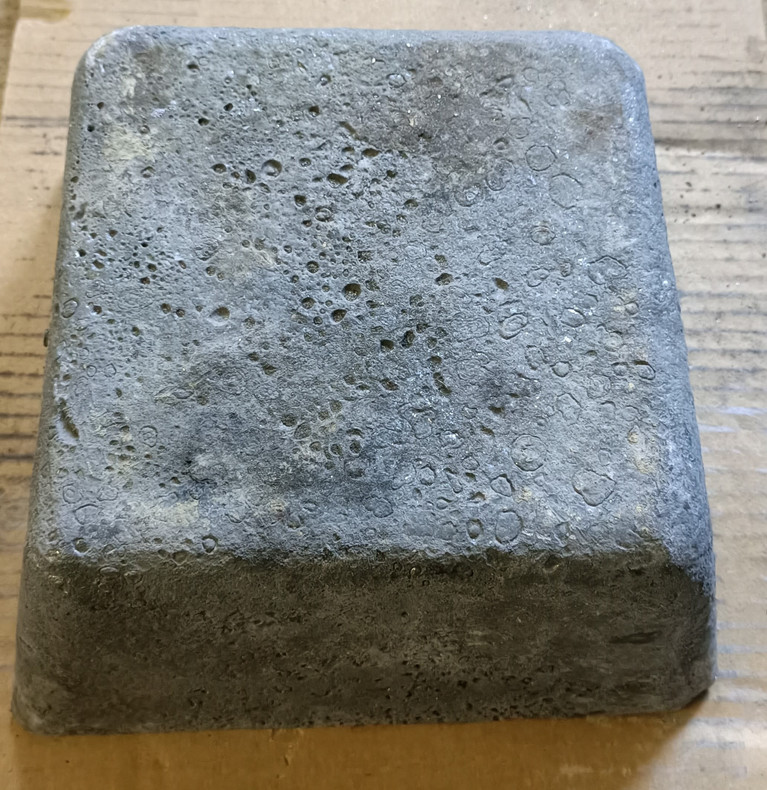Use: casting bullets, sinkers, lures or many other uses.
The best element to use to harden lead is Antimony, Sb.
This element will give a hardness of around .9 BHN (Brinell Hardness Number) per one percent of Antimony in the alloy.
As pure Lead has a hardness of 5 BHN adding 5% Antimony will give a hardness of approximately 9.5 to 10 BHN. This is the alloy mostly used in good quality shot. It’s much harder than pure Lead.
For most applications this hardness is quite sufficient. If you are using recycled Lead you may get some variation from whatever hardness you have predicted, due to other elements that were already in there.
Most Lead sheet/pipe/flashing etc. is already fairly pure though – normally around 99% plus purity to start with.
Wheel weights are a much harder alloy. These have Antimony in them already. It’s wise to note however, that many are not made of Lead these days. They are often Zinc, so check your batch first.
Important Safety Note: The dust and fumes from Antimony are dangerous to your health. Never breathe in the fumes or dust and wear gloves and normal Lead casting PPE.
Using Tin Vs Antimony
Many people add Tin to harden Lead. While this will work, Tin is nowhere near as efficient at hardening Lead as Antimony. Tin does however aid in the ‘wettability’ of the alloy and very much improves the casting properties. Therefore, if you need detailed or precise castings it is worth the expense to add in a little Tin.
Around 1% up to 3% of Tin is enough to improve the castability of your alloy. Any more will add very little hardness to most applications, and just make it a more expensive alloy.
The Antimony Alloying Process
Now the problem with Antimony is, unlike Tin that just melts into the Lead, Antimony is a frustrating beast to deal with sometimes!
Here’s our recommended process:
Step 1: First weigh out the required amount of Antimony and break it up nice and fine.
Handy Tip = Put it into a plastic bag, wrap in a newspaper and whack it with a hammer several times. The bag will get holes in it but the paper will contain the powder. You can then open the paper and just tip the powder/lumps into your melt pot. Any little bits of paper or plastic that fall in will burn off.
Step 2: To mix it first melt your Lead.
Getting the Lead hotter than normal casting temperatures helps dissolve the Antimony.
Don’t boil it – but heat to a higher temperature than you would normally cast at.
Step 3: Add in your broken up Antimony.
The Antimony will float and not mix in. Add the tin after the Antimony has heated up a bit and then flux, stirring while you do so. The tin helps break up the surface tension and lowers the overall melting point of the alloy – and both help the Antimony dissolve into the melt.
It will take a while for the lumps of Antimony to melt into the Lead so be patient with this step.
As for fluxing, one of the very best fluxes available is beeswax. It’s natural and non-toxic and a very effective flux. You can also use paraffin wax or just about any other wax or oil, some people even use olive oil!
Tip= a bit of sawdust can help while fluxing! Common powdered wood is a surprisingly effective flux especially if used in conjunction with beeswax, it will burn off but helps reduce oxides and seems to help with the alloying.
We use our special beexwax sticks as a flux for all our Lead and Tin products, as it’s clean and quite effective.
Billing Metals & Manufacturing’s Aussie made BeeFluxed, is a product specifically intended for Lead casting in a handy to use stick.
You don’t need much of this stuff either, a pea sized piece is enough to flux around 10kg of alloy.
Quantities
Now we come to how much Antimony and Tin to add.
There are endless different Lead alloys you can use depending on your needs.
If you are making hard cast pistol bullets you will need a hard alloy of around 3% to 5% Antimony with 2 or 3% Tin to get good fill and detail.
If it’s fishing lures probably just a 2-3% Antimony alloy with maybe 1% tin to help alloy it.
For most designs of sinkers, the hardness is probably not that important. However a shape with thin spots or weak points would benefit with the same alloy as lures.
For anti-corrosion uses, a 5-6% Antimony alloy with no Tin is the most suitable, this is also the alloy most used in high quality shot.
It is not a bad idea to experiment a bit with a small batch to work out what you need. It is easy enough to change the alloy by adding more Antimony or Tin or you can dilute it back by adding more Lead.
Keep a record of what you add and the results, and it’s easy to replicate what works best.
Finally, cast into ingots
Lastly, we recommend making up a batch of alloy, cast that into ingots or billets etc, then remelt to make your end product.
Doing things this way tends to result in cleaner casting and a more consistently mixed alloy.
Happy casting and stay safe!
